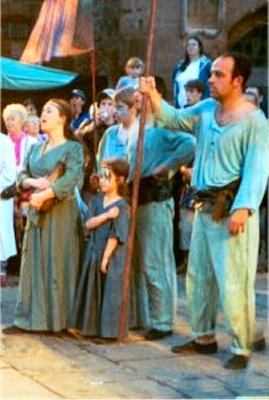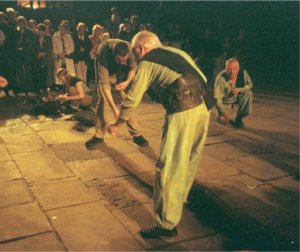Why Collaborate?
The short answer is that collaborations strengthen communities and provide more successful art experiences for participants.
Some important aspects of collaborating in an arts project are:
Collaborations have the potential to strengthen communities.
They can have a synergistic effect, both within and beyond the immediate project. In other words, collaborations give people the experience of creating something bigger than themselves or one leader's vision. Jointly accomplished tasks enlarge both our sense of self and our sense of what is possible for the community.
Collaborating leads to greater appreciation of others' abilities.
It creates new perceptions of the partners, and builds new and expanded relationships within the community.
Collaborations are more work, but they are also more fun.
Collaborations make sustained success more likely in long-term projects.
Collaborative projects, because they are based on partnership's within a network, with access to a large expertise base, and because they, don't rely solely on the energy levels of one person, tend to persist and grow through time and get re-funded.
Arts collaborations help strengthen communities another way.
They provide the community-kids as well as adults with a model for how things can work, how well tasks can be accomplished, when it is a team project which bridges separate community institutions and clientele.
Patrick Overton, Ph.D. Director, Columbia College Center for Community & Cultural Studies
Collaborations and partnerships are two different words. It is important to understand this difference.
A collaboration means at least two different individuals / organizations involved in a joint effort. It requires a great amount of communication and coordination. A collaboration consists of an agreement but it is usually informal. There is no legal contract involved.
On the other hand, a partnership may or may not require joint effort. One can be in partnership with someone else and with the understanding that only one of the partners will do the work. A partnership requires an agreement, usually much more formal than a collaboration, resulting in a legal contract. It must be monitored and evaluated on a continual basis in order to insure its success.
I have personally and professionally been involved in both collaborations and partnerships. I want to spend some time discussing my experience and what I have learned along the way to help you establish successful creative collaborations and partnerships.
Creative Collaborations:
Creating Mutual Benefit
A. Establishing the Motive Why?
Why do you want to work with another organization?
Why do you want your organizations to be involved with each other?
What is your motive?
These are more than surface questions. They provide the foundation upon which any successful collaboration must be built. Each party in the collaboration must be clear about who they are, what they do, and why they do it.
These are questions that relate to the core mission/vision of the organization and the answers must be premised on the foundation of the organization, the core values. I have witnessed many failed collaborations because the parties involved simply didn't know who they were themselves and they entered the relationship for the wrong reason. The worst reason of all is financial motivation. That will sink a collaboration quicker than anything else, because it gives the impression that all you are interested in is the resources, not the shared experience.
The question that should be asked is why you want to create a collaboration. The answer to the question why is the driving force that will make or break the collaboration If the why is clear for you, and clear to those with whom you are participating in the joint project, there will be open and honest communication. No hidden agenda. No backstage political shenanigans. Isn't that refreshing.

County Galway Community Arts Network
B. Is There Mutual Benefit
Over the course of the last seven years, I have been very involved in working with arts organizations in the Pacific Rim. Organizations in Asia are very different than they are in Western countries. One of the most important lessons I learned, and I learned it very early on in my experience overseas, is that whatever you do, you must establish mutual benefit. That is, you must be dear what each participant in the collaboration is going to get out of the joint experience. I think this is a very wise approach, in any setting. And, while we may not always be able to answer yes to both the human and financial question, there are many times when entering a creative collaboration can be of mutual benefit.
This is especially true when viewing the questions of human and financial capital. The fact is, it is not at all unusual for one organization to have the financial capital and the other the human capital. This mutual benefit, if dearly understood and defined early on, can bring into existence a balanced and productive collaboration. This requires each part of the collaboration to be clear about itself, what it wants, what it hopes to gain, what it needs to make the collaboration work.

County Galway Community Arts Network.

County Galway Community Arts Network.
C. Does the Collaboration Fit In Your Strategic Plan?
When I do organizational development work, especially with rural and small communities, I quite often find there is little planning in place. When I do find it, it is usually some project budget for six months to a year that was created when the budget was created for a grant application. Most small organizations I know consider a grant proposal a plan. Unfortunately, this isn't true, leaving most organizations with no real road map on how to get to where they want to go. Strategic planning is intentional, self-directed, and dearly articulates not only what it is you want to do, but who is going to do it, when, and how it is going to get done.
There are three questions I always ask in working with an organization to develop a strategic plan. These are especially relevant when preparing for a collaboration. First of all, does the project/program fit your vision/mission/value statement? That is:In my country, I have noticed a trend toward the arts becoming very involved in the social service sector. I worry about this, as it extends an already very thin and fragile volunteer pool. I conducted a workshop last year when a person asked me whether or not I thought her organization should get involved in a grant program offered by the social service agency of her community. When I asked her about the agency and what it does, she couldn't answer the question. She didn't know who they were but she was willing to ask them for money and enter a collaboration. Trust me, we are just as revenue hungry in the United States as you seem to be in this province, but you have to draw the line somewhere. I see many organizations go after grants (which, by the way, I generally put into the Partnership Category), in order to get the revenue, never once thinking that it will end up redirecting the organization's efforts, energies, and enthusiasm.Does it fit who you are or are you going to have to change to fit it?
Is it what you should be doing?
Is it what you want to be doing?
The second question I ask is just as important.
"Is someone else already doing it?"
This seems simple enough, but many times we don't realize that while we think this project/program is important, we may not be the ones who should be doing it. I think the arts in the United States, especially community arts, needs to begin to examine this closely. There simply aren't enough resources to go around. The public funding pie is getting too small. And the last thing we need, especially in rural and small communities, is a dogfight for a pitiful piece of a dwindling pie.
The third question I ask is the one that many times leads to the collaboration I am talking about here today.
"Do you have the resources?"
By this, I don't just mean the financial resources, I also mean the human capital. In nonprofit organizations, especially in the arts, we greatly underestimate the value of the time we are given by our volunteers.
Is this what we want them to spend that time doing?
Is this the best use of their time?
Is this what they signed up to do?
So many times we drive our volunteers out of our organizations because we never take the time to talk with them and find out if we are meeting their needs. This is not to slight the financial concern - obviously, this is an essential consideration in this day and age. If, after viewing all of this, you decide to move forward, if it fits in your plan and the collaboration makes it possible for you to fulfill your mission and be true to your organizational values, then go for it, it's worth the risk!
D. Who Is In Charge of the Collaboration?
Someone has to be in charge. I don't care how democratic you want to be, someone has to assume the responsibility for making the collaboration work. Equality is great, if it can be achieved. It may be, the mutual benefit of the collaboration is that one of the collaborators has the leadership to get it done. If it is to be a co-chaired collaboration, fine, but conditions have to be clearly spelled out. People have to know what it is that is expected of them. Far too many times, I have been involved in a joint venture and experienced frustration because my expectations weren't fulfilled. Unfortunately, many times, I have found out the reason was as much my fault as theirs. Again, I harken back to the need for effective communication.All collaborations must be explored, explained, and experimented with before they ever become reality. We have to explore all options, possibilities. We have to anticipate all of the variables. Most of all, we have to explore each other and the topography that lay in front of us before we begin our organizational journeys together. In other words, we have to be working off the same map or we will surely get lost and spend a lot of time wandering around the countryside. None of us have time for this. The fact is, while we may be clear of our core values and why we think the collaboration is important, we may not be as clear about those with whom we are exploring a relationship. In interpersonal communication terminology, this is the experimenting getting the lay of the land (to continue my metaphor). It should be slow and easy, taking the time to get to know each other. To enter a creative collaboration and put all of your organizational capital (including your name) at risk, without knowing those with whom you are collaborating, can be a very dangerous act.
In the process of getting to know each other, experimenting with various configurations and constructions for the collaboration, you must be clear about expectations. Because of my focus on organization's having an effective "e value action" instrument (consisting of a clear case statement of the values, vision, and mission); this is an excellent place to begin. As you can tell, this is why I insist that successful collaborations must begin with successful organizations. And all successful organizations are clear about who they are, what they do, and why they do it.
When you have accomplished all of this, and you shouldn't rush into anything, you begin to establish the ground rules—this is where the explaining comes in. In a sense, you join your corporate cultures together. But this doesn't mean you have to give up power. Some of you know I am an ordained minister. In the wedding ceremony I use, most of which I wrote myself, I have a segment early on when I charge the couple with remembering mat they are not being asked to give up their individuality, but rather, sharing as one, they become more than they could ever be alone. That is the wonderful concept of relationship. When it works, when it is successful, there are two individuals who are sharing together,creating a new thing between them. I don't want to stretch the marriage analogy too far, but I will say that it is certainly like living with someone for a while. Whatever happens, neither one of you will be the same when it is over. My goal is to encourage you to establish collaborations where, because of clear expectations and open channels of communication, everyone knows what to expect. When this happens, magic can occur. Things can be done no one ever dreamed could be accomplished. I spent eight years in a town of 6,500 people in the middle of rural Missouri, I have seen it and I have experienced it myself.
Unfortunately, I have also experienced what happens when this open communication doesn't occur. In rural and small communities, the end result can be devastating. Once trust is broken in a small community, it takes years for the wound to heal. So, whatever you do, move slowly, carefully, and communicate with each other. If you do, the experience will be positive. And, even if the collaboration fails (and sometimes they do), you both will have learned. Who knows, the relationship may be strong enough for you to try it again. And this time it will work.

County Galway Community Arts Network.
Partnerships
Partnerships are different than collaborations. Collaborations are generally temporary, flexible, and have a lot of room for movement. On the other hand, partnerships are more structured, clearly defined. Partnerships are more formal. Many times, partnerships permanently alter the nature of organizations because they bring the issue of governance into the picture. For example, your organization may choose to enter a partnership with the federal/provincial government. The government provides the financial (usually not enough to get the task done) and you provide the means to accomplish what is agreed. With this fund- ing comes very strong stipulations about your organization, governance, membership, etc. Unfortunately, far too many organizations get involved in these formal types of partnerships without really examining the essential questions. The most important question is whether or not the values driving the partner are the same as those driving your organization. In many instances, especially in the public funding sector, this is not the case.
I published a monograph last spring entitled
"Public Trust or Public Trough:
The Ethical Crisis Facing Nonprofit, Tax-Exempt, Cultural Institutions in America."
While I was specifically referencing organizations in the United States, I can safely say, my short stay in Canada assures me that the term North America would be accurate. Many organizations go after public and private money, regardless of whether or not there are shared values. My experience has been, it is not only sometimes the case, but rather, consistently the case, that public and private hinders are quite comfortable insisting (sometimes even demanding), that you abide by their values. And, out of desperation, we traipse off after the almighty dollar, leaving behind our own sense of who we are.
In my country, I get accused of being against public funding for the arts. But I am not. Over the course of my professional life, I have raised, in public and foundation grants, over $500,000 for programs and projects in which I am involved. I have no problem using public funding, but I am very careful of the "fit." You have to have a fit. You will notice I do not use the term mutual benefit when it comes to partnerships. While I wish it were the case, I rarely see mutual benefit occurring in this setting. The question we have to ask ourselves is:
Who are we serving?
Who gets the benefit?
Is it worth the tradeoff.

County Galway Community Arts Network
Can there be successful, healthy partnerships?
Of course. But they have to be worked at and monitored. It takes time and effort and most partnership relationships are really utilitarian. There is very little "relationship" about it.
When it comes to establishing partnerships, I propose you move not only slowly, but cautiously. Community arts development is not a shared value. I do not know of a lot of people in public funding, and in the local community setting, who know or understand exactly what it is we mean when we use this term. A lot of us who work in this field are not clear about what it means. I know a lot of public and private funding programs are designed to emphasize an arts product, the performance, not the process of creating it. Those of us who are community arts developers may be quite content with a positive, exciting process that enables people in our communities to experience the arts on a personal basis. But, with the kind of funding criteria (excellence, for example) that we use in the United States, I know a lot of public and private funders that are much more concerned about the bottom line.
How many people came?
What was the quality of the product?
Did it accomplish its purpose?
These are very different expectations. These are two very different value systems. Unfortunately, we do not always understand the differences and it can be very harmful to an unsuspecting organization. So, seek creative partnerships, but do it in conjunction with what you want to do. Be clear about expectations and who is in charge. Establish a dear understanding of what it is that each partner can expect. And, if you can live with the conditions, fine. But, keep one thing in mind:
Partnerships do not have to be permanent. They can be temporary. Be willing to examine and explore the value of the partnership each time you proceed into another joint venture. Keep it fresh and keep it creative.

County Galway Community Arts Network.
Conclusion
Creative Collaborations and Partnerships are well worth exploring. We can't do it all by ourselves. Many times we need help. The two key ingredients that must be in place for either one of these to be successful is being clear about your own values/vision/ mission and, open communication. If these two things are in place, there is no reason not to proceed. Sometimes these things work. Sometimes they are a disaster. The important thing is that everyone knows what to expect and is willing to work together to see it come to fruition.
And one final note. I want to emphasize the word "creative" in the title of this workshop. It is very important to be willing to try something new. In fact, one of the great "mutual benefits" of creative collaborations and partnerships (yes, partnerships can be creative, but only if we make it happen) is that it brings excitement into your organization. Sometimes new can be just what is needed to breed excitement and enthusiasm. The problem is that we are usually so careful and cautious, we never get to the point where we are willing to risk failure. And that is what is so great about rural and small communities. They are laboratories— one of the few places left in our societies where we can experiment and, if necessary, fail. But isn't that what experimenting is all about— experimenting until we get it right. We have placed such a product mentality on the arts we assume if an experiment fails, we shouldn't have done it. No! If it fails, we need to learn from it, and experiment again, and again, and again—until we get it right.
If what we are trying to accomplish is so important we were willing to enter into a relationship with another organization or agency, it is worth doing until we get it right. If this is a shared value in the collaborations and partnerships you enter, you are in for a great experience.
